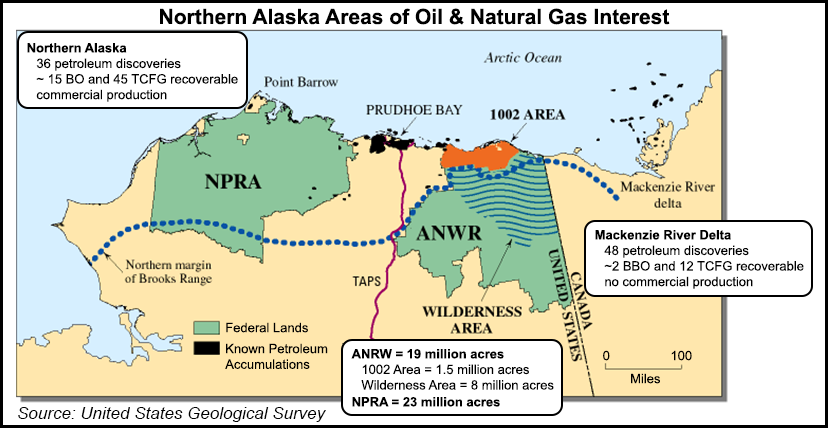Regulatory | E&P | NGI All News Access
Bill Would Allow Limited Development of Alaska’s 1002 Area
Alaska’s two U.S. senators introduced legislation on Thursday to open a non-wilderness portion of the Arctic National Wildlife Refuge (ANWR) to limited oil and gas development.

The bill — S 49, the Alaska Oil and Gas Production Act — would allow development of no more than 2,000 surface acres within the 1.5-million acre coastal plain of the ANWR, a region also known as the 1002 Area.
“For nearly 40 years, Alaskans have proven that we can responsibly develop our natural resources while protecting the environment,” U.S. Sen. Lisa Murkowski (R-AK) said in a statement. “Alaskans overwhelmingly support responsible development in the non-wilderness portion of ANWR and there is no valid reason why we should not be allowed to proceed.”
U.S. Sen. Dan Sullivan (R-AK) said it was “shameful” that the federal government has been ignoring decades of pleas by Alaskan officials to allow limited development of the 1002 Area.
“Development of this area would be a boost to our state and national economies, providing thousands of good-paying jobs and billions of dollars in federal and state revenue,” Sullivan said. “Because energy can be used as a tool for power and diplomacy, developing Alaska’s abundant reserves would also strengthen our national security.”
S 49 is expected to be referred to the Senate Committee on Energy and Natural Resources, which Murkowski chairs.
In a separate statement Thursday, Alaska Gov. Bill Walker also endorsed the measure.
“The state will do everything it can to provide the infrastructure needed to responsibly access the 1002 section of ANWR,” Walker said. “Alaska has developed the seismic technology needed to focus on the most resource-rich portion of the area, allowing us to limit the footprint of activity in the region.”
Federal and state officials are concerned that declining throughput on the Trans-Alaska Pipeline System (TAPS) could force the pipeline’s closure, a move that could devastate the state’s economy.
“Since the ANWR coastal plain is less than 60 miles from TAPS, development in this area is the quickest, most environmentally sound way to increase oil production in Alaska and ensure the pipeline will continue to operate well into the future,” Murkowski’s office said. “Safe and responsible development is already taking place at Point Thomson, which is located on state lands immediately adjacent to the invisible boundaries of ANWR.”
Walker added that “with an oil pipeline that is three-quarters empty and an over $3 billion budget deficit, drilling in the 1002 [Area] would fill TAPS and bring much needed revenue to our state coffers.”
According to the U.S. Geological Survey (USGS), the portions of the 1002 Area controlled by the federal government hold an estimated 7.7 billion bbl of technically recoverable oil. The USGS estimate climbs to 10.4 billion bbl with the inclusion of Native lands and adjacent state-controlled water areas within a three-mile offshore boundary.
The State of Alaska first announced plans to assess oil and gas resources within the 1002 Area in 2013, but the plans were rejected by the U.S. Fish and Wildlife Service (FWS). Alaska subsequently sued the FWS in 2014, arguing that it is authorized to explore the region under the Alaska National Interest Lands Conservation Act. A federal court disagreed and blocked the state from conducting 3-D seismic exploration and drilling of the area in July 2015.
© 2024 Natural Gas Intelligence. All rights reserved.
ISSN © 1532-1231 | ISSN © 2577-9877 |
